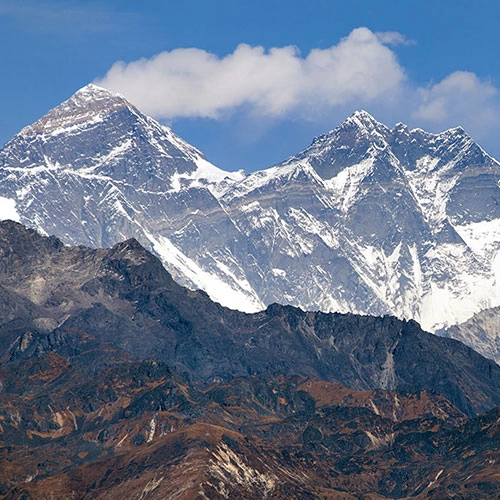Everest High Pass Trek Overview
The Everest High Pass Trek is one of the most thrilling, adventurous, and rewarding treks in the Everest region of Nepal. If you are experienced explorers seeking remote trails, high-altitude crossings, and panoramic views of the world’s highest mountains, then this can be the best choice. This challenging circuit trek in Everest takes you over two major passes—Kongma La (5,535m) and Cho La (5,420m). This high pass trek with ECB brings you to the iconic spots like Everest Base Camp, Gokyo Lakes, Kalapathar, and Bustling Namche Bazar.
The wonders of Gokyo lakes, the world’s highest mountain base camp, and the scenic view from Kalapathar will make your trip more fascinating. Since this trek is only intended for physically fit and experienced hikers, it is rated as challenging and complicated, making it more thrilling for people who enjoy taking on difficulties.
The journey for the Everest high pass trek starts with the breathtaking flight to the land of the Sherpa. Then, after starting our hiking on Spectacular landscapes, around majestic lakes and mountain vistas that ensured the charm of the trip.
Trekking in the Everest region is always exciting and challenging, but this high pass trek is even more challenging and demands enough trekking experience, physical fitness, and good health conditions. During this trip to Everest, trekkers experience the homelands of the friendly Sherpa people and their colorful culture, and the way they work out with daily chores, picturesque villages, and monasteries that represent popular Nepal culture in the Himalayas.
Weather & Challenges During the Trek
The high pass trek in Everest presents significant physical and environmental challenges, including extreme altitude, changeable weather, and long hiking days, especially while you have to cross the high passes. The passes are often snow-covered and icy, requiring high-altitude hiking experience and stamina. Acute Mountain Sickness (AMS) is a real risk, so acclimatization days are very crucial.
The weather can change swiftly. You might experience warm sunshine and freezing wind or even snow all within a few hours. Temperatures can drop below -15°C (5°F) at night, especially above 4,500 meters. Bad weather and snowfall may bring a challenge and can block the passes as well, so it is highly suggested to have flexibility in the itinerary.
Best Times to Trek the Everest High Pass Route
Picking the best time for the High Pass Trek in Everest is very crucial. Choose the best season that is fit your travel date and plan your high Himalayan adventure.
Spring (Late March to May): During this time of year, the weather is warm, with clear skies (especially in the morning to midday), blooming rhododendrons. Such a weather condition is the best time for this high pass trek, and it makes a top choice.
Autumn (late September to November): The weather is warmer in March and getting colder in October and November, clear skies offer the best visibility of the mountain view, ideal for crossing high passes.
Food & Accommodation During the High Pass Trek
Accommodation: Despite the remoteness of the trail, trekkers can expect decent teahouse accommodations at each place where you have to spend an overnight stop. Rooms are basic with shared bathrooms and limited heating, but they are cozy and clean, often with spectacular mountain views. Some places like Namche, Dingboche, Gokyo, and Lukla, you’ll have comfortable rooms with attached bathrooms.
Meals: along the trek to Everest high pass, foods are freshly prepared at teahouses and typically include Nepali dishes like dal bhat, chapati with curry, noodles, pasta, soups, momos (dumplings), Tibetan bread (fried in oil), and pancakes. Hot drinks and snacks are available in every teahouse along the trail. Places like Lukla, Namche, Dingboche, and Gokyo, you’ll also find bakeries and cafés offering a variety of bread, cookies, and coffee.
Why Book with Us (Local Travel Agency)?
Booking through a licensed local trekking agency guarantees safety, experienced guidance, cultural insight, and cost-friendly options as per your needs. Our local guides know the terrain, weather conditions & importance of quick action, and emergency procedures. For your comfort and ease, we will handle all logistics—permits, domestic flights, accommodation, guide, porters, and contingency plans for high-altitude conditions. To plan your budget for this trip, you can also check our article: Everest high pass trek cost and get brief information.
We, “Green Society Adventure” specialists, also support sustainable tourism, giving back to mountain communities, and ensuring ethical treatment of porters and staff. We promised to provide better value and a more authentic trekking experience in the mountain terrain of Nepal.
Connect with us and make it a lifetime experience! We are here to organize the trip as per your needs.




